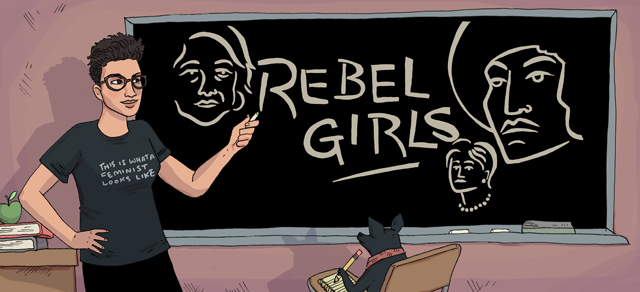
Header by Rory Midhani
Illustrated by Rory Midhani
Women’s studies. What the fuck is that? I want to show you today a short explanation of how today’s most feminist classrooms came to be — but first, let’s define the damn thing.
Let’s stick with the Wikipedia definition. (I always loved encyclopedias. Remember Encarta? Good times, y’all.)
Women’s studies, also known as feminist studies, is an interdisciplinary academic field that explores politics, society, media, and history from women’s and/or feminist perspectives. Popular methodologies within the field of women’s studies include standpoint theory, intersectionality, multiculturalism, transnational feminism, autoethnography, and reading practices associated with critical theory, post-structuralism, and queer theory. The field researches and critiques societal norms of gender, race, class, sexuality, and other social inequalities.
Here’s how it got that way.
Colleges Decide Women Are, In Fact, Not Too Cool for School
According to Marilyn Boxer, the history of Women’s Studies lies deep within the history of women in academia. She envisions the institutionalization of the program — one which expands every year — as a natural next step for the movement to include women in academic work:
Women’s studies can be viewed as a third phase in American women’s struggle for equal access to higher education. In the pre-Civil War era, women such as Lucy Stone demanded and sometimes won admission to institutions of higher learning, but generally they had to settle for special programs of study deemed suitable for their sex. In a second phase, in the later decades of the nineteenth century, women such as M. Carey Thomas called for admission to the “men’s curriculum,” both in new colleges for women that aimed to equal the private Ivy League institutions that educated men of the elite, and in state-supported, land-grant universities that promoted “coeducation.”…Beginning in the mid-1960s, enterprising women with feminist consciousness launched a third phase. Declaring coeducation a myth, they challenged the content of higher education as well as academic structures and procedures that taught a hidden curriculum of women’s second-class status.
Throughout the 19th century, women fought for and won the right to private and public higher education admissions in various ranks. Oberlin College would make history in 1837, when it integrated its campus; the Seven Sisters sprouted up between that same year through 1889 in an effort to maximize opportunities for women who were either banished from university life or silo’ed within sexist programs on other campuses. Women’s studies would evolve out of this yearning for academic knowledge — and the desire to be reflected in its teachings.
Feminism Becomes An All-Powerful Force
As women began to rise as academics, they also found themselves rising in the streets. The activism that made the 1960’s and 1970’s a historic time for America influenced the social and political climates of campuses and the ideas of the academics within them. Boxer writes that the various movements of those times “laid the basis for wholesale rejection of standard academic requirements,” and also fueled a movement among students and faculty alike for more diverse perspectives and lessons on university grounds.
Students led the women’s studies movement by virtue of demanding it in what Boxer describes as “massive numbers” and with “major influence” on those in charge of their institutions. “We needed feminist awareness to see ourselves as primary agents,” Boxer writes, “and to recognize that women matter. We began to ask new questions about our foremothers and ourselves. We wanted to study about women.”
Women Faculty Join The Revolution
Women who were already involved in academia at this time also felt the impact of the burgeoning feminist movement in their work. By holding their colleges accountable to their perspectives and history, women activists on campuses in the 1960’s and 70’s laid the ground for women academics to rebel against their own disciplines. Whereas they had once fought to become part of a patriarchal ivory tower, they were now ready to disintegrate its faulty sexism and break the barriers of their respective fields with respect to gender.
Dorothy Smith challenged the field of sociology — a stronghold for women’s studies, even today — as inherently sexist in a 1972 essay in which she claimed outright that “how sociology is thought — its methods, conceptual scheme and theories — has been based on and built up within, the male social universe.” She echoed what other academics at the time were feeling, especially those active in establishing women’s studies for the specific purpose of countering the inherent sexism of the social sciences and liberal arts, whom Boxer recalls were asked if they would have enough material. What Smith was proposing for sociologists, however, also marked a turning point in the development of feminist research methods and curriculum development: the demand that the lived experiences of women be integral to their study.
I am not proposing an immediate and radical transformation of the subject matter and methods of the discipline nor the junking of everything that has gone before. What I am suggesting is more in the nature of a re-organization which changes the relation of the sociologist to the object of her knowledge and changes also her problematic. This re-organization involves first placing the sociologist where she is actually situated, namely at the beginning of those acts by which she knows or will come to know; and second, making her direct experience of the everyday world the primary ground of her knowledge.
Women’s studies would be a powerful counter in years to come to the myths that women did not contribute to history or the development of our culture or even to the present-day societies they were shaking up. Women’s studies, now often criticized for contributing to a gender divide in academic realms by those who fear making issues of gender separate ensures they remain that way, began as an earnest attempt to redistribute academic power and knowledge.
Women’s Studies Academics Come To Campus
In 1969, Cornell offered the first-ever Women’s Studies course in its Spring semester. In 1970, San Diego State University launched a women’s studies program. This happened, of course, in a very strange time for the feminist movement.: the Lavender Menace remained a dying specter for those in the streets, and racial divides were common between activists. Women’s Studies would start suddenly and expand even more unexpectedly and along the journey, it would also come to evolve and grow exponentially in ideas and perspectives.
The first women’s studies programs were less interconnected with their academic neighbors than the WGST classrooms of today. Throughout the 70s, the focus was on defining and establishing the field, and ultimately, in the 80s, that focus shifted to what Beverly Guy-Sheftall called “mainstreaming”: Programs became interdisciplinary, and the goal ultimately became not establishing sexism-free programs of study but on ridding all programs of study from sexism.
In 1972, Feminist Studies and The Women’s Studies Quarterly were founded. Women academics analyzing issues of gender now found themselves able to publish their perspectives and debate one another in an academic forum. (To add some perspective, women’s studies folk can now submit to 30 journals or publish in the widely-growing bibliography of books in their field.)
In 1975, the National Women’s Studies Association was founded — an organization that, to this day, fosters academic feminist thought. From their website:
Our commitments are to: illuminate the ways in which women’s studies are vital to education; to demonstrate the contributions of feminist scholarship that is comparative, global, intersectional and interdisciplinary to understandings of the arts, humanities, social sciences and sciences; and to promote synergistic relationships between scholarship, teaching and civic engagement in understandings of culture and society.
With every addition to the academic realm of women’s studies comes not only legitimacy but reach. Readings are no longer solicited only from the field, as anyone who has taken more broad Anthropology or Sociology courses could tell you. Women’s studies becomes a more integral part of academia with each print.
Intersectionality Becomes Core
“Today, one of the first things students learn in women’s studies classes is how to look at women’s lives through multiple lenses,” Bonnie Thorton Dill wrote in a 2009 study on Women’s Studies in Ms. “The concept of intersectionality has been a key factor in this transition. Intersectionality has brought the distinctive knowledge and perspectives of previously ignored groups of women into general discussion and awareness, and has shown how the experience of gender differs by race, class and other dimensions of inequality.”
Once women’s studies had gained traction, it began to expand to include a diversity of perspectives. In the 1980s, feminist academics became concerned with the white, middle-class dominance of their field; in 1982, the book All the Women Are White, All the Blacks are Men, But Some of Us Are Brave brought to the forefront a desire for incorporating “minority women’s studies” into the realm; in 1984, bell hooks published the groundbreaking Feminist Theory from Margin to Center which would demonstrate the importance of a field rich in variance; and in 1989, Kimberle Crenshaw coined the term “intersectionality” in a piece that railed against the exclusion of women of color across various movements for social justice.
Queer politics also became immersed in the field as feminist theorists began to branch out into sexuality studies, queer theory and gender theory — and as groups like NOW gave up the Lavender Menace and came to embrace oftentimes radical lesbian and bisexual politics. Lesbian separatists emerged; Judith Butler declared gender a performance; Ann Fausto-Sterling destroyed notions of any truly “biological” definition of sex; and in 2006, the first-ever anthology of transfeminist writing went to print. As the feminist movement – both in the mainstream and the fringe trenches – queered itself, its journey to encompassing all women churned along.
Soon enough, the growing breadth of what constituted a “women’s issue” began to open up the discipline. In the early 2000s, academics across the discipline grappled with a title for their field. Programs struggled to capture what their courses encompass in a title or acronym, meaning that our experiences may sound less universal than they are.
Is it Gender Studies? Women’s Studies? Women’s And Gender Studies? Sexuality Studies? Gender and Sexuality Studies? LGBT Studies? Queer Studies? Feminist Studies? Likely, if you’re enrolled in something under the women’s studies umbrella, your major falls along one of those linguistic lines, although each one ensures a slightly divergent and different educational path.
Coursework in a women’s studies class today might cover issues of race, sexuality, gender expression and identity, sexualization and socialization of women, global women’s rights and various international diaspora, history, art or peace. Women’s Studies remains an interdisciplinary field, making its name all the more difficult to decide on. Is it Women’s History and Theory, or is the program really Lesbo Recruitment 101?
One thing’s for sure: You won’t know until you try it.
Eventually, Everyone Will Take Women’s Studies
Ms. magazine found that over 900 programs in the women’s studies field were functioning in the US in 2009. That meant 10,000 courses teaching over 90,000 students at 700 colleges and universities across the nation were fueling critical thought on gender, class, race and sexuality. That included 31 Master’s programs and 13 Ph.D. programs across the country and the world. Women’s studies (or whatever you want to call it) has come to contain multitudes, and it has come to a place of broad and important impact.
“In these 40 years since its inception,” Beverly Guy-Sheftall wrote in the introduction to the Ms. study, “women’s studies has revamped and revitalized major disciplines in the academy.” She continued:
It has challenged curricular and pedagogical practice. It has disrupted the male-centered canon. It has altered or blurred the boundaries between disciplines. It has introduced the social construction of gender and its intersections with race, class, ethnicity and sexuality as a major focus on inquiry. And it has experienced phenomenal and unexpected growth, becoming institutionalized on college and university campuses, spurring the hiring of feminist faculty, adding graduate courses of groundbreaking content, generating a large body of educational resources and providing the impetus for the establishment of feminist research centers. It has stimulate the development of other academic fields as well: gay and lesbian studies, cultural studies, gender studies, men’s studies, peace studies, and more.
Women’s studies began almost half a century ago, but it has now become an integral partner to the feminist movements happening in Congress, on the streets, and in our everyday lives. Women’s studies has informed how we act, shaped our dialogue and transformed our perspectives, and it is now more than ever enabling us to better fight our challengers, come together with our peers and declare our own identities.
Readings For This Unit
- “Women’s Studies as Women’s History.” Boxer, Marilyn. Women’s Studies Quarterly, Vol. 30 No. 3/4. Permalink.
- “Women’s Perspective as a Radical Critique of Sociology.” Smith, Dorothy. Sociological Inquiry, Vol. 44 No. 1.
- “Forty Years of Women’s Studies.” Ms. magazine. Spring 2009. Permalink.
- “Demarginalizing the Intersection of Race and Sex: A Black Feminist Critique of Anitdiscrimination Doctrine, Feminist Theory and Antiracist Politics.” Crenshaw, Kimberle. The University of Chicago Legal Forum, 1989. Permalink.
- The Politics of Women’s Studies: Testimony from 30 Founding Mothers. 2000. Howe, Florence.
- Theory from Margin to Center. 1984. bell hooks.
- All the Women Are White, All the Blacks are Men, But Some of Us Are Brave. 1982. Hull, Gloria, Patricia Bell Scott, Barbara Smith.
Rebel Girls is a column about women’s studies, the feminist movement, and the historical intersections of both of them. It’s kind of like taking a class, but better – because you don’t have to wear pants. To contact your professor, email carmen at autostraddle dot com.
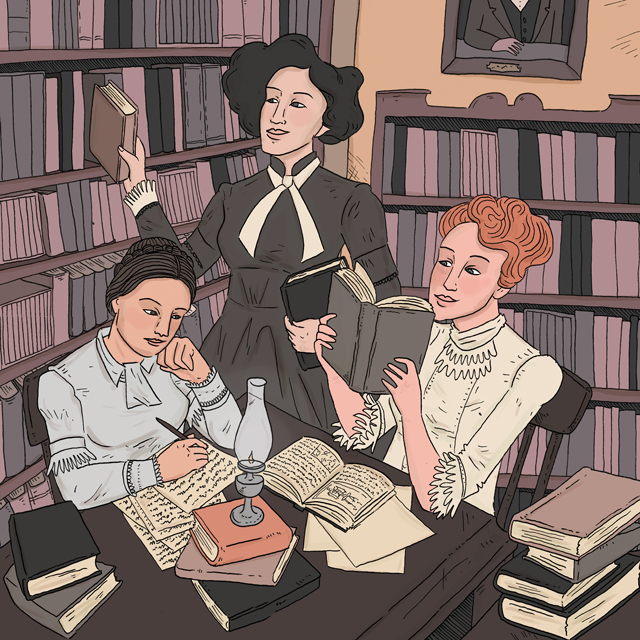

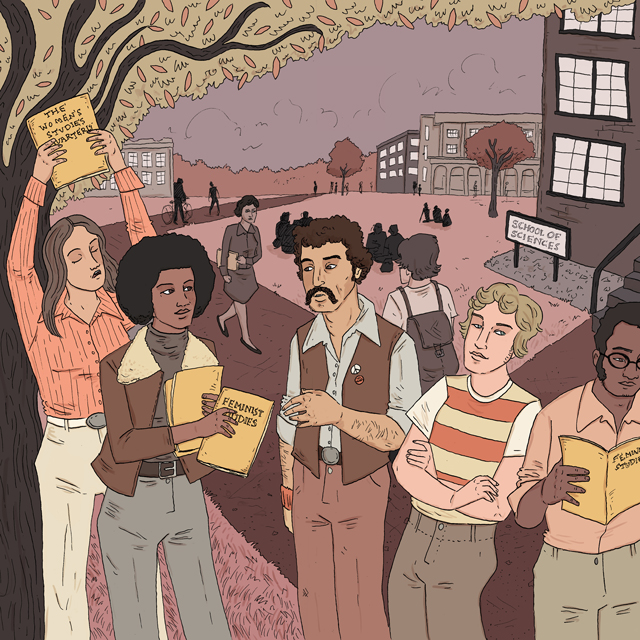
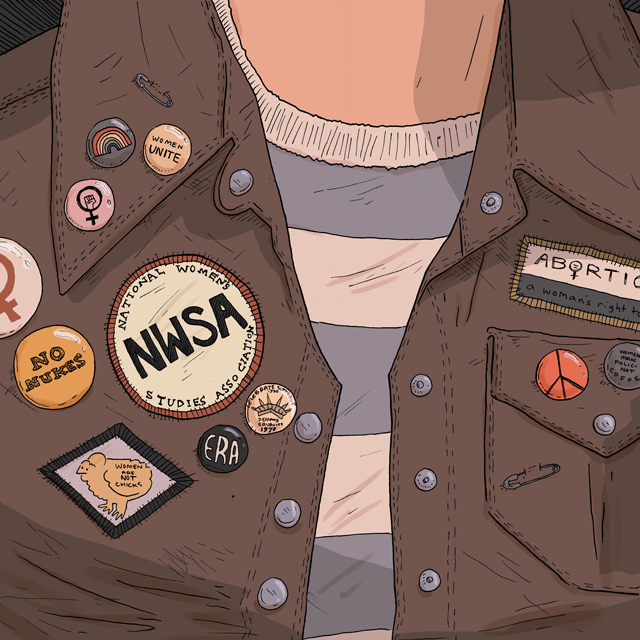
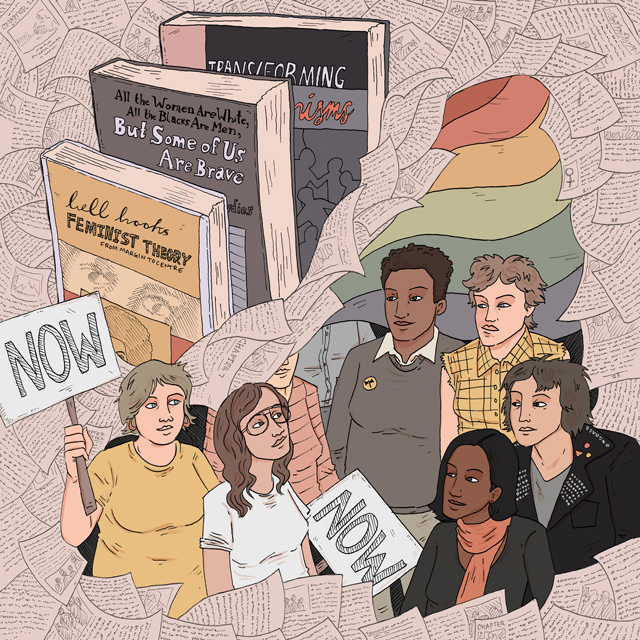
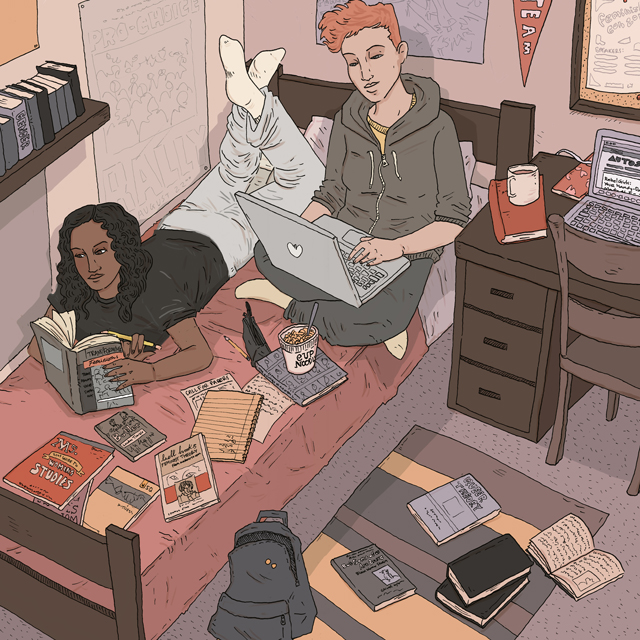

I appreciated this article and am confused by the lack of comments.
My school’s program was revamped and renamed about a year ago – we are now Critical Identity Studies.
these illustrations are LOVELY.
thanks for putting this together, Carmen! learning the history of the field was not something we ever did in my WMST program.
Great article! I loved my Women’s Studies course at my community college because I learned a lot and gain new information that I thought I knew
Great article, very informative. Thanks for posting!
Carmen, thank you for this overview, but I find a section of it really problematic:
“The Radicalesbians and Mary Daly emerged, demanding a separate nation for women; so did trans theorists, in years to come. In 2006, the first-ever transfeminist anthology went to print, bridging the inevitable gap between Judith Butler‘s declaration of gender as performance and acceptance in the feminist movement for gender variance.” I think there are some serious misstatements of fact in here. First of all, there was transfeminist writing published before 2006. Sandy Stone’s “The Empire Strikes Back” was in 1984 and that is absolutely transfeminist writing. Also, your equating what Mary Daly wanted and what any transfeminist ever wanted is bizarre. You’re writing this as though you equate the two. Mary Daly (and others of her ilk) compared trans women to rapists. They purposely misgendered them, kicked them out of every possible feminist space, even compared them to “Frankenstein.” I don’t know of any possible statement from a well known member of the trans community which is even vaguely an equivalent to that. Moreover, while some transfeminists (like Kate Bornstein) supported aspects of Judith Butler’s writing and the entire concept of “gender as performativity” or as “purely a social construct,” there are many other trans writers who find these to be sweeping generalizations and oversimplifications. To just pretend as if they’ve been grafted into Gender Studies programs and everything is hunky dory doesn’t represent reality. Julia Serano’s recent book very much critiques how universally a lot of Butler’s ideas have been wholesale and even unquestionably adopted by such programs.
hey! let me clear this up – thanks for the feedback! less than equating, i was hoping to just assert a rise in actual queer voices – yes, mary daly and her ilk definitely found themselves at odds (and being awful) to trans feminists – but the movement as a whole was moving away from normative and essentialist ideas of womanhood overall. that’s all. i can fix the wording to make that more clear but wanted to comment as i won’t be home for a good while! thanks for that catch – i obviously in no way want to conflate or give credence to the stuff you described. (i also want to add that the first transfeminist ANTHOLOGY is certainly not the first transfeminist writing. it’s the first anthology. that’s different!)
I understand the temptation to paint the history of women’s studies as an upbeat progressive march towards including all women’s voices, but a lot of influential women resisted or actively fought against intersectionality.
When discussing the contributions of these women I think it is important to acknowledge both the harm they caused as well as their intellectual achievements.
Mentioning them in only a positive light hides the harm they caused. While mentioning only their hateful rhetoric might leave someone confused as to why they were ever influential.
Though my response was mostly due to your casual mention of Mary Daly, I think your summary of events in the 80s and 90s could have been expanded a bit. (Sorry if this comes across as a bit confrontational, I am a bit under the weather at the moment.)
“but a lot of influential women resisted or actively fought against intersectionality.”
Why the past tense? For a sense of progress? Technology has a superior and fully automated solution for that too: http://progressquest.com/
Serena, since I couldn’t figure out how to respond to your comment, I replied to my own (hope it shows up correctly).
I guess I was trying to not sound negative and maybe I went a little overboard. I know some people in the field of women’s studies are still very hateful, but I don’t think such thinking is as influential or mainstream as it was in the 80s and 90s.
But you are right, I was trying to encourage the author to not think of the history of women’s studies as being a continuous march towards progress and in the process I simplified things myself.
Carmen, you’re right about me misreading the “anthology statement”… I just want to make it clear that transfeminism is not some incredibly recent phenomenon and that it goes back to the 70s. But I did ignore the word “anthology” so thanks for the correction. As to the other, Women’s and Gender Studies programs have an all too unfortunate history of transmisogyny which is only now starting to thaw. Moreover, certain kinds of trans writers (like Bornstein) tend to be emphasized and assigned as reading over others due to their affirmation of much of what has been taught in Gender Studies programs. I’m glad that’s all changing but, along with institutionalized racism and classicism, its historical context shouldn’t be ignored.
Really nice article.
In my university there’s a lack of spaces to discuss about women issues in a more progressive perspective. I study psychology, and we usually see what men say about development, sexuality, organization of psych structures, etc… I’m really tired to read about how women are passive and have penis envy.
There’s always (thank God) someone who questions this stuff. In the last semester we have formed a feminist group only with women and I see some other iniciatives in other colleges.
Ps: [I’m in an extension project in a organization that supports battered women.] I never understood when lesbian sites suggested feminists/gender groups to meet more lesbian until recently, when I realized that at least a half of the people in the project are gay
reading this article in 2022! thank you for this, i found it to be very helpful!